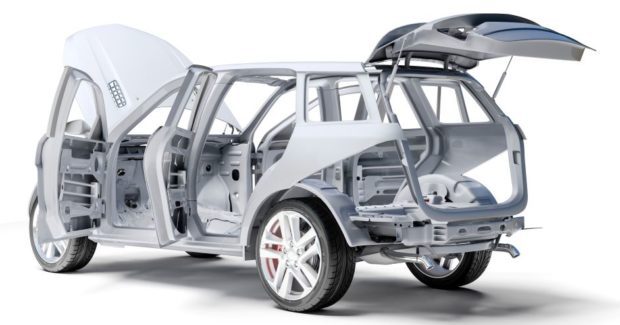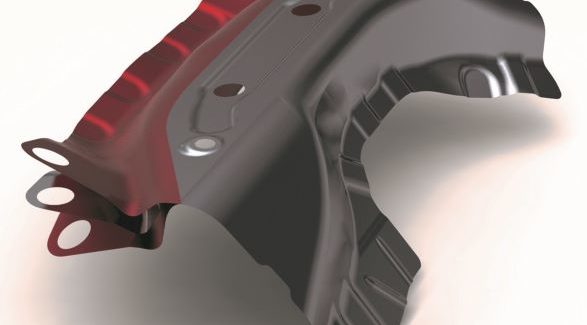AI Isn’t Going to Take Your Job, But It Will Make You Better at It
Artificial intelligence and machine learning will continue to influence and disrupt manufacturing, generating processes that get smarter with each new software and computing development. Manufacturing simulation has a key role to play.
Posted: October 22, 2021
TOWARD ZERO DEFECTS
By Mike Lee
We have new challenges in metalwork. These are best articulated in automotive, where the industry is undergoing the biggest disruption in 100 years with the electrification of cars. The automotive giants risk obsolescence if they don’t put new models into production fast enough, and with lightweight and extremely energy-efficient post-ICE designs at a price-point that consumers are willing to pay.
This means more models, smaller batches, and a good deal of new development work in very compressed timescales. Throughout the supply chain, there is more need than ever to understand the cost and feasibility of production decisions quickly and act on them.
Here, manufacturing simulation has a vital role to play. But the tools need to be accurate, easy to use and very efficient. Organizations also need to become more efficient. Designers don’t communicate enough with the people planning or doing the manufacturing, and that remains a problem on both sides of the fence.
Applied well, artificial intelligence (AI) and machine learning (ML) can democratize knowledge because it exposes non-experts to new insights in easy-to-understand formats. It opens the world of simulation to people that aren’t “finite element” experts. We expect these new technologies to continue to influence and disrupt manufacturing. Manufacturing is becoming smarter with each new software and computing development.
Virtual manufacturing and costing tools have succeeded in making simulation practical for manufacturing. For example, OEMs rely on sheet-metal simulation software to help advanced planning and production teams make informed costing decisions. Today, it’s used to monitor and refine body-in-white (BIW) designs from concept to production by bringing costing, manufacturing, and tooling teams together to evaluate design choices by material utilization, formability, process design and tooling — but it’s underpinned by physics-based simulation and costing information.
Tier II and Tier III suppliers use some of the same tools to work out the material cost and feasibility of new jobs so they can provide quality, time, and cost benefits to their customers. For welding, joining, and even additive manufacturing, simulation helps manufacturers plan their processes to avoid deformation from warpage and shrinkage, and to quickly achieve better quality by avoiding waste with design-for-manufacturing insights.
But there remain practical limitations. Simulation can take multiple hours to multiple days of analysis, depending on the physics you are solving. Furthermore, someone needs to feed in a design or new parameters, then test each hypothesis to find the best result. It might not be good enough to keep up in the eMobility era — what if you have a new design, need to try different material gauges, or even different materials. Can you explore the options quickly enough, and how will you find a winning cost — weight — manufacturability trade-off?
One approach is to create a system with a data-based model that represents the physics-based model. For example, there are machine learning platforms developed specially for Computer-Aided Engineering (CAE) that ‘learn’ the relationship between a system’s input and output from past analyses. This enables engineers to predict the outcome for a given scenario much more quickly. Because it would take days or even months to perform thousands of finite element analyses (FEA), engineers limit their scope to three-to-five runs to determine a solution. Modern AI/ML techniques take the same parameters/results and find the best reduced order model (ROM) technology (from dozens), creating a dataset of thousands of iterations that they can use to determine the optimal result. It’s also possible to generate a digital twin by leveraging both numerical and physical test data to account for uncertainty and variability.
MECHANICAL JOINING
In a single vehicle, there can be as many as two hundred “stack ups” of sheet metal material and gauge configurations. Safety requirements dictate we prove the strength of these riveted joints in BIW structures, but each requires a different rivet or process. Physical testing could cost $1,000 per pull-test; so simulation has significant benefits.
However, most automotive OEMs still depend heavily on physical testing despite the material waste and labor costs. Simulation dramatically reduces cost, but it can still take 1.5 hours per simulation. It adds up because that equates to 300 hours (12.5 days) per vehicle and must be repeated if there’s a design change.
We found that by training a machine learning model with a base set of these trusted physics-based simulation, we could create a tool that accurately predicted the pull-test results for a given stack-up in two seconds.
Of course, the same approach could be applied to analyze strategies for welding battery packs, for example, where the process is more complex.
TAKING THE GUESSWORK OUT OF SPRINGBACK
Sheet-metal professionals are all-too familiar with the age-old challenge of springback. It can be difficult to predict the dimensional changes that occur after components are removed from the stresses of forming tools and partially spring back to their former position. Resulting in inaccuracies can diminish the styling of a car body or render any pressed part out of tolerance.
Experienced fabricators can compensate for springback by, for instance, overbending a simple linear feature on a press brake. While this approach may consistently work when material behavior is predictable, overbending untried materials entails a significant amount of guesswork, scrap, and wasted machine time. Likewise, performing additional operations or altering tooling to reduce stress may work well with a familiar material, but isn’t conducive to making the most of better-performing materials or quickly reacting to changing demands.
Simulation helps explore these problems, for example:
- If I change the gauge, what will be the amount of springback?
- If I modify the tooling, will the springback be localized or global? These can be very counter-intuitive, and simulation gives the direction and magnitude.
- If I change my design with countermeasures like radius coining, embossments, darts, will it solve the problem?
Virtual trial-and-error is a lot better than physical, but you still need years of experience to know what to try. Today, we have tools that help production to check if a design is feasible. They are made for manufacturing because you don’t need to be a CAE expert — simulation will show you the result of your design for manufacturing adjustments. As machine learning becomes accessible, we can create a dataset of simulations once then run an optimization that will tell you which is the best combination of geometric countermeasures, material property or gauge for a given part. Once you’ve run those initial physics-based simulations you can move the goalposts and find the best solution almost instantly. That’s a huge leap forward, that can be considered at concept stage and its benefit is multiplied if design, costing and production stakeholders come to the table.
AT CONCEPT — BUSINESS AND PRODUCTION IN ONE GO
Virtual engineering has never been more important in volume sheet metal production. Regular hot-rolled steel costs have reached a historic high of $1,700 per ton, compared to a low of $440 per ton in August 2020 during the pandemic. What’s more, the lead time is also two-to-three months. It’s absolutely critical to make the right decisions, quickly, if you are designing a new vehicle.
Automotive OEMs such as Ford and Toyota identify trimline modifications to maximize material utilization and determine if there is an opportunity to downgauge. They assess their challenges holistically by evaluating the total Body In White:
- All BIW Weight
- Blank Weight
- Part Weight
- Material Utilization
- Coil Pitch, Width
- Optimal Nesting
- Early Forming Feasibility
Process simulation is key so that a designer or forming specialist can look at how to use new materials, such as advanced high-strength steels, magnesium, and aluminum alloys that require new techniques and process plans. New materials have different processes and unique behaviors that can influence styling and design. At concept, you’re interested in the cost, time to market, styling challenges and confidence in quality.
The primary benefit is to provide the information required to proactively identify and address material utilization related issues on new designs. By identifying and targeting components that do not meet targets and/or show regression from legacy models, OEMs will see three-to-five percent improvements in overall material utilization and BIW weight per vehicle platform. Applying AI/ML to this process allows OEMs to real-time track and monitor material utilization for every revision of every sheet metal component for every platform globally. Without AI/ML, this process can only be updated every two weeks, whereas with AI/ML this becomes a real-time process.
SMART MANUFACTURING FUTURES
AI and ML complement physics-based simulation perfectly and are revolutionizing manufacturing. Physics-based and data-based simulations capture data that physics-based models alone can’t capture fast or accurately enough. Ideally, there is a future in which all elements of the manufacturing processes are working together.
The term “digital twin” has been thrown about for a long time, but they are closer than you might think, and machine learning is the key. The challenge for these more advanced applications of AI and machine learning is that you need data — and lots of it.
There is great need for such AI and ML approaches in additive manufacturing. Additive manufacturing sounds simple — printing ideas — but there is so much happening in terms of the physics that getting the quality needed for high precision or industrialized applications requires manufacturing simulation. It has the potential to replace low-volume, high-cost metal injection molding. Using simulation, process planners can now predict the shrinkage caused by factors such as the thermal strain, friction, and gravity during sintering without specialist simulation knowledge. Sintering-induced mechanical stress can be predicted before print, indicating where defects might occur. Manufacturers can use this information to make changes earlier in their product development and reduce the need for costly redesign.
However, finding the best geometry and process parameters is a balancing act. Put this into serial production, and you want to be sure you’re avoiding conditions that could affect quality and make continuous improvements over time. Here, the ability to operationalize simulation and use predictions in combination with measurements of the external geometry, surface finish or internal porosity can help the machine builders or the manufacturers using their machines to achieve closed-loop control of the process.
These multi-physics problems can be overwhelming, and AI can be used to discover unknown relationships in these systems without fully solving the physics. Using some real-world measurements to produce data-based models helps to reduce these unknowns without needing to reproduce every effect with math.
At Hexagon, we see these predictions as integral to smart manufacturing, connecting design engineering, production and metrology technology into one digital thread. But you don’t need to wait until you can transform every step in development and production.
I hope this short exploration has shown that AI and machine learning can help address some immediate and practical issues in daily operations on the shop floor and production planning, and incrementally make manufacturing smarter by bringing design and manufacturing people and processes closer together.
Mike Lee is the Lead Applications Engineer – Virtual Manufacturing and Costing for Hexagon’s Manufacturing Intelligence division. Email mike.lee@hexagon.com.













